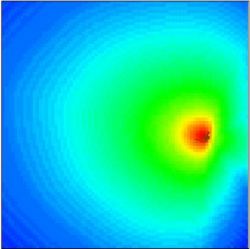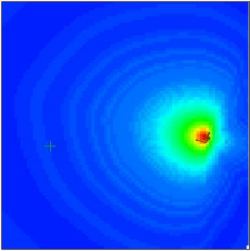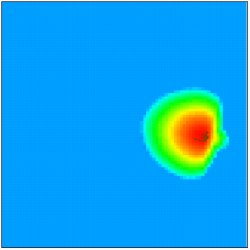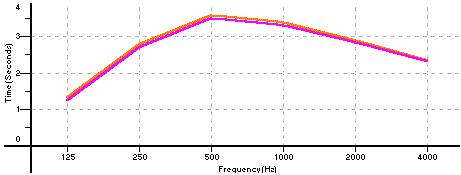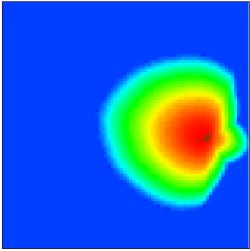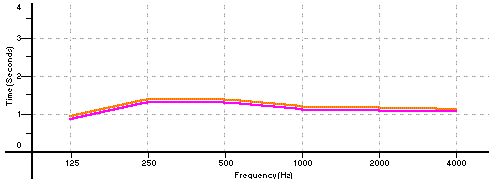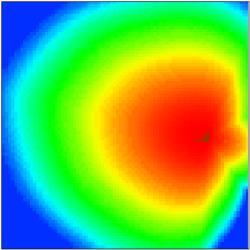
Main Page Related Pages |
Classroom Speech IntelligibilityControl of excess of reverberation time is a critical factor in providing speech intelligibility in classrooms. We modelled a 40'x40'x10' (12m x 12m x 3m) classroom with three different acoustical conditions to show the effect of reverb time on speech intelligibility for an unaided talker. The Voice as a SourceBefore we look at the intelligibility results, let's look at the teacher's voice in a classroom. The first sound level plot we have shown here is the sound level of the voice by itself, ignoring the room's contribution or effect. In the plot below note that the colour range represents a sound level range from a minimum of 51dB for dark blue to a maximum of 78dB for the red. There is a total of 27dB of level range shown on this plot, from the talker's mouth to the back corner of the room. Again, this is only the direct sound from the talker. Listen to the dry speech sample, with no reverberation. WAV File (110kB) - MP3 File (23kB)
In the level plot shown below, we have the direct plus reverberant sound level shown combined on the same plot. Note that the total range represented on the plot runs from a minimum of 65dB in the dark blue to a maximum of just over 81dB in the red, a total range of just 16dB. Once we add the energy contributed by the reverberation in the room, the overall level increases and the range of sound level variation is reduced from 27dB to only 16dB. This room has a nominal mid range reverb time of 1.2 seconds. This seems like free amplification, especially when you see the great improvement in the sound level at the back of the room. Note that there is almost no visible change in sound level beyond 15-20 feet away from the talker. The point where the sound level of the reverberant field is equal to the direct sound level from the source is called Critical Distance (DC). And while you can gain some intelligibility from this reverberant sound energy, it is absolutely dependent on signal to noise ratio. For this to work effectively there is a requirement to have the desired speech signal be at least 15-25dB above ambient noise levels and local noise sources (coughing, throat clearing, paper or foot shuffling etc.) Adults working in their mother tongue can get by with less than 6dB of S/N ratio where the information is expected and known, but really require a 15dB S/N ratio for a learning environment. Children learning language and adults in ESL (English as a Second Language) need a full 25dB of S/N ratio to have reasonable speech understanding. Read more about the effect of background noise levels on intelligibility.
IntelligibilityThe plots below show the modelled %ALCons, or Percent Articulation Loss of Consonants. This describes the percentage of consonants that will be misunderstood or lost in conventional speech (assuming 25dB of signal to noise and a proficient talker and listener). For general sound system applications (churches, airports, arenas etc.) a %ALCons design target of 10% would be reasonable. For educational applications a more stringent criteria of 5% should be considered, as we have to work harder to absorb new information, we can't be struggling to understand the words at the same time as we're trying to understand their meaning. 3.5 second reverberation timeThe first plot is the room without any acoustical treatment, typical of the room under construction with all hard surfaces. We've probably all had experiences of trying to talk to someone in this type of room. The total range of the first plot covers a minimum of 26% ALCons in the medium blue to a maximum 0% at the red. Notice that we quickly reach and exceed 10% ALCons at a distance of approximately 8-9 feet from the talker.
1.2 second reverberation timeThe plot that follows is the room with a midband RT of 1.2 seconds, very typical of a classroom with students as the primary absorption, plus some glued on ceiling tiles and the balance of the surfaces hard and nonabsorptive (tile floor, GWB or concrete block walls, glass windows, hard seats and desks, etc). The total range shown here is a minimum of 10% shown by dark blue and a maximum of 0% shown in red. In this room, we manage to just meet or exceed 10%ALCons throughout most of the room, with just over 1/4 of the room meeting 5%ALCons or better. If the room is very quiet this may be just adequate, although students that understand more may do better in school.
Listen to the classroom with 1.2 second Reverb time
0.6 second reverberation timeThe last room model has a nominal midband reverb time of better than 0.5 seconds, typical of a classroom with suspended ceiling tile and a full class. The total display range shown on this plot is a minimum of 3.9% shown by the dark blue and a maximum of 0% shown in red. Note that the entire room meets or exceeds 3.9% ALCons, this room will have excellent speech intelligibility support and can better tolerate the typcial intermittent noises that are generated by the students.
Listen to the classroom with 0.6 second Reverb time
It's not just huge rooms that have speech intelligibility problems caused by excess reverberant sound energy. In very large rooms (like arenas) the reverberant level will be diminished by inverse square law attenuation due to the travel distance to the wall surfaces. In a large room, it requires a much louder sound source to excite the reverberant field throughout the entire space, and the onset of reverberation takes a fraction of a second longer since the walls and ceiling are much further away to start bouncing sound around. In a small room the reverberant sound level is quite high compared to the source sound level, and the reverberant level builds faster and is loud enough to significantly mask subsequent syllables or words. Why does excess reverberation affect speech intelligibility? Acoustical Society of America's booklet on Classroom Acoustics Main Page > Design Services > Schools > Print version of this page |
|||||||||||||||||
